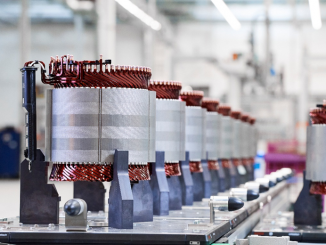By Caroline Wilson, Director of Investor Relations • Matamec Explorations, Inc.
Background – Dudley Kingsnorth (IMCOA, March 2011) has outlined ‘Ten Steps for Developing a Rare Earth Deposit’ that Matamec has used as a guideline in developing its Kipawa Heavy Rare Earth Deposit.

Matamec Explorations, Inc. is a junior mining exploration company whose main focus is in developing the heavy rare earths-yttrium-zirconium Kipawa deposit located in Temiscaming, SW Quebec. It is also exploring more than 35 km of strike length in the Kipawa Alkalic Complex for rare earths-yttrium-zirconium-niobium-tantalum mineralization on the surrounding Zeus property (see Figure 1 for property location and infrastructure). A timely, high value and low cost mine is being fast-tracked to be in production by early 2015.
The viability of the project is emphasized by a simple mineralogy rich in the rarer heavy rare earths (HREEs); a well defined NI-43-101 compliant indicated and inferred resource with plenty of upside; a flat-lying ore body that extends to surface and is open pittable with a low strip ratio; an ore pre-concentration process that eliminates 65 percent of the ore; a simple, low cost recipe for extracting the total rare earths as an oxide (TREO); and an easy, accessible infrastructure in a mining friendly province.
End users, such as the car industry, are interested in Kipawa’s critical metal content (such as dysprosium) and are capable of absorbing its entire product, as illustrated by Matamec’s recent strategic partnership with Toyota Tsusho Corp. (TTC). In the recent MOU, steps were outlined that will lead to the eventual financing of a definitive feasibility study and the financing of the capital expenditure. An off-take agreement will be negotiated whereby TTC will buy 100 percent of the Kipawa production and a joint venture agreement will split only the Kipawa Deposit, with Matamec retained as the manager and owning 51 percent.
The company is also exploring for gold, base metals and platinum group metals. Its gold portfolio includes the Matheson JV property located along strike and in close proximity to the Hoyle Pond Mine in the prolific mining camp of Timmins, Ontario. In Quebec, the company is exploring for lithium and tantalum on its Tansim property and for precious and base metals on its Sakami, Valmont and Vulcain properties. It is also exploring for gold in conjunction with Northern Superior Resources, Inc. on the Lesperance/Wachigabau property.
Developing a Rare Earth Deposit
Rare earth projects are inherently different from commodities such as gold, silver and the base metals. While the demand for base metals is driven by mature sectors with average growth, the rare metals are in demand in new sectors such as electric and hybrid cars, energy efficient lighting and displays, as well as alternative energy such as windmills, all of which should experience above-average growth in the years to come. In addition, Rare Earth Elements (REEs) can be considered as industrial minerals where a possible end user must be identified during the earliest steps of the development of a deposit. Rare earth elements are customer-specific chemicals, produced to precise chemical and physical specifications. The suppliers must become an integral link in the supply chain as the customer needs are continually evolving. The final precipitation of a total rare earth concentrate must meet the needs of the end user.
Developing a rare earth mine typically takes seven to 20 years. Matamec started work on the Kipawa Deposit in 2007 and should be in production by 2015. Dudley Kingsnorth has outlined 10 steps required before a deposit will go into production. Initially, Step 1 is an inferred resource must be identified and drilled to NI-43-101 standards, Step 2 is the mineralogy and metallurgy need to be defined in the laboratory, followed by Step 3 is a scoping study or preliminary economic assessment (PEA) to establish the initial viability of the project (capex and opex ±35 percent). The location of the Kipawa deposit near to supporting infrastructure (transportation, power, water, chemicals and skilled labor) brings Matamec’s costs down and a high concentration of heavy REEs increases the value of the deposit. Matamec’s PEA defines a resource with 70 percent of the resource in the indicated category and 30 percent in the inferred category. Presently, a 12 to 16 year mine life is projected. However, there is plenty of upside as the deposit remains open in all directions.

Identification of the mineral(s) containing the REEs is an important stage in determining the amenability of the ore to cost-effective processing. Liberation size of the RE mineral(s) should not to be too fine so that they are amenable to conventional beneficiation techniques such as flotation, gravity and magnetic separation. Kipawa’s main REE-bearing mineral is Eudialyte (Figure 2). It is medium grained, well-crystallized and not intergrown with the other minerals. A simple, low cost recipe for extracting the total rare earths as an oxide (TREO) includes an ore pre-concentration process, by magnetic separation, that eliminates 65 percent of the Kipawa ore before the hydrometallurgical process begins. A simple acid leach using 150 kg of acid/t of ore at room temperature has been outlined with excellent recoveries. Additional elements of Matamec’s PEA include: the completed baseline environmental studies and a site chosen for the processing facilities. The local communities and relevant government agencies have been consulted and are kept up to date with regular meetings.
The next steps in developing the Kipawa Deposit include Steps 4 to 6 the pilot plant(s) in three stages: Step 4 is beneficiation, Step 5 is extraction and Step 6 is separation. The goal is to produce samples for customer evaluation from a three stage pilot plant that has operated continuously for at least 10 days. These data will be used in the definitive feasibility study (DFS) and demonstrate the technical viability of the project. Matamec has announced that it has reserved a time slot with SGS Lakefield to build a mini pilot plant during May and June 2012. In the meantime, optimization tests are ongoing and Toyota Tsusho Corp. is repeating the tests in Japan in association with their chain of supply. Access to the technical expertise of the Toyota chain of supply is a significant advantage for Matamec, allowing savings in both time and cost.
Step 7 involves the environmental approval process. The extraction and separation processes, associated chemical transport and storage, and radioactive waste management are facets of a project that are always subjected to detailed study by the local environmental authority and the public. All rare earth minerals contain U and Th for which acceptable waste disposal techniques have to be demonstrated. The pilot plant generates data for the Environmental Impact Study.
To be successful, a RE company has to integrate its operation into the supply chains of its customers, which requires mutual trust. Customer relations need to start in the early stages of the project, as their specifications are the basis for planning the pilot plant. Generally, in Step 8, Letters of Intent (LOIs) are required for a substantial portion of the proposed production prior to the final pilot plant run and the commencement of the Definitive Feasibility Study (DFS). Matamec had signed confidentiality agreements with several end users before entering into a memorandum of understanding (MOU) with Toyota Tsushu Corp. in December 2011. In a three-step process, Toyota Tsusho will significantly de-risk the project providing funding for the DFS and arranging funding for the mine build as well as buying 100 percent of the Kipawa production.
Matamec is well prepared heading into Step 9, the DFS and Funding of the Kipawa project. The RE resource remains to be upgraded to a measured reserve, and the pilot plant and permitting processes have commenced. Normally the Definitive Feasibility Study (DFS) is the document upon which funds are raised for project construction and LOIs are converted to sales contracts. The MAT/TTC MOU outlines a timeline and way of financing the Kipawa project through to production and sets the stage for the negotiation of an off-take agreement and joint venture between Matamec and TTC by the end of June 2012.
Matamec expects to complete a DFS in 2013. In a DFS, the required level of accuracy (±15 percent) for the capex and opex dictates that 25 percent of the engineering will have had to be completed. Typically a DFS costs 8 to 12 percent of the capex; for example, the cost of a DFS for a project with a capacity of 10,000 tpa TREO could well be $30 to $50 million. Matamec projects costs under $20 million.

The RE production facility is a complex processing operation that requires a sophisticated level of engineering more appropriate to a chemical plant than a mining operation. This step requires a high level of chemical expertise and RE operational experience which is not readily available today outside China. Step 10 concerns the engineering, procurement, construction and start-up of a mine. Matamec is preparing for this stage of development by hiring an experienced vice president of Construction and Development, Bertho Caron. It will also benefit from its strategic partnership with Toyota Tsusho Corp. and its supply chain.
Exploration is ongoing on the Zeus property outside of Matamec’s deal with TTC (see Figure 3 for property outline). Several showings have been identified particularly the Surprise Showing, located on the western limb of the Kipawa Alkalic Complex. Initial channel sampling of a stripped outcrop shows 5.3 percent TREO (66 percent HREO+Yttrium/TREO) and 3.6 percent Zirconium oxide and 3.9 percent Niobium oxide. Soil sampling has identified two, more than 1 kilometer long, soil anomalies that show the same chemical signature as the outcrop. Summer exploration results are pending.
Developing the Kipawa Deposit in a timely manner gives a ‘first to market’ advantage in a sector where an undersupply of the Heavy Rare Elements, particularly the five critical elements (Nd, Eu, Dy, Tb, and Y), is projected for 2015.
About the Author
Caroline Wilson graduated with a BSc in Geological Sciences from McGill University. She subsequently completed the course requirement for a Masters Degree in Geochemistry from Université de Montréal. She is a founding member of the Association des Géologues du Québec. She spent her early career as a geologist for the Quebec Ministère des Ressources Naturelles et de la Faune (MRNF) mapping volcanic rocks in the Quebec Abitibi region and went on to work for several Senior and Junior mining companies exploring for gold, base metals and diamonds in Quebec and Africa. She has 20 years of field work experience to her credit. For more information visit www.matamec.com.
Published in the Spring 2012 Issue



